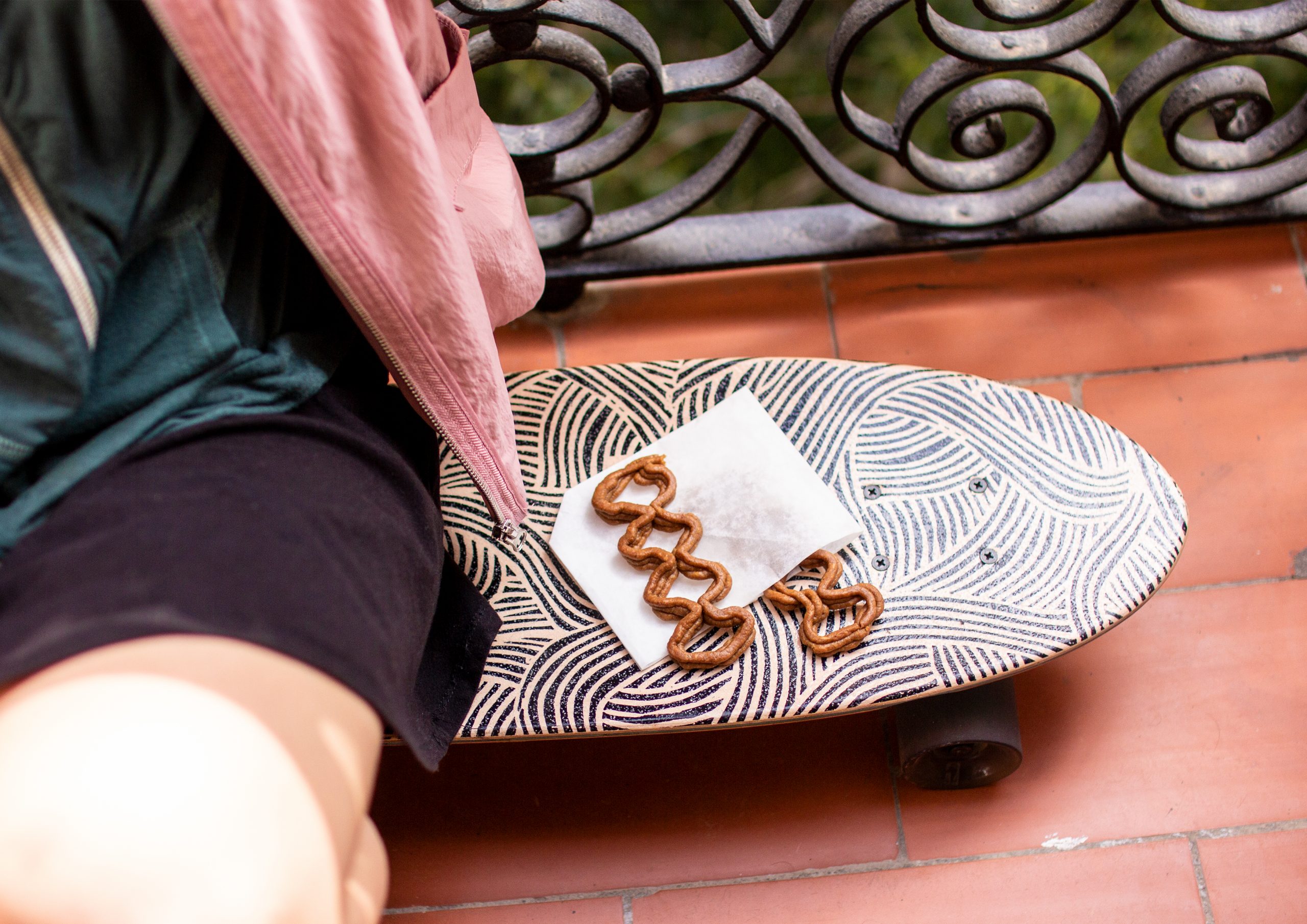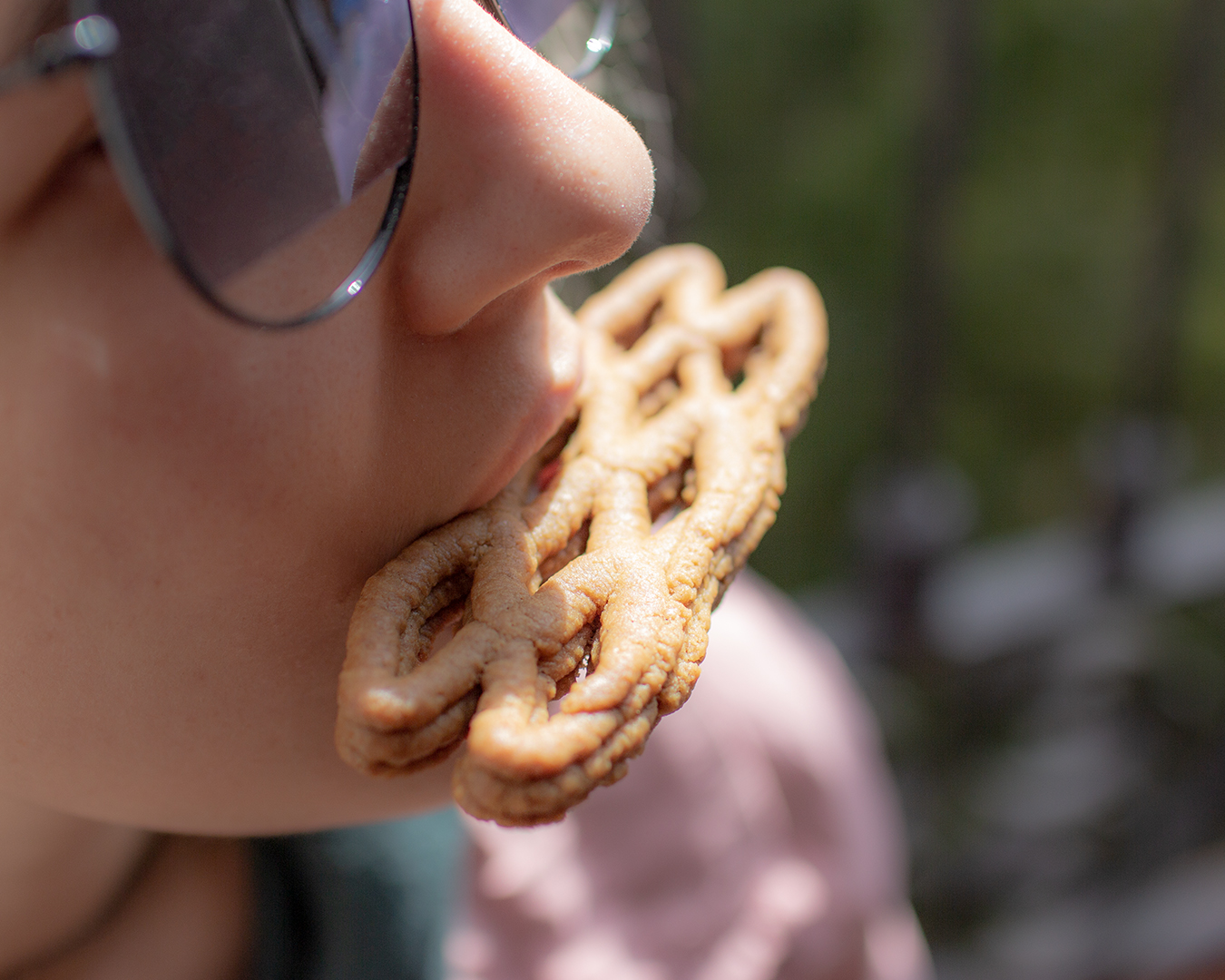Look Ma' No Hands

Useful information
- Team members
- Secil Afsar
- Country
- Spain
- Keywords
- circular economy generative design parametric design 3D printing food waste customized food foodshed open-source sustainability healthy food unconventional food production a new sensory experience texture design edible architecture micro and macro design of food
Short Description
3D-printed healthy snacks from fruit and vegetable peels
Detailed Description
The project challenges the question of what is a waste. In modern kitchen habits, mostly in western countries, people tend to discard their peels. However, it is well known that these discarded peels contain a high amount of fiber, vitamins, and nutrients like the fleshy part.
People do not prefer to eat fruit and vegetable peels due to their texture and bitter taste. While steaming the peels to develop 3D printable paste is reducing its bitter taste without losing the nutritious part, with micro-level 3D print extrusion technique their textures can be redesigned. After collecting the discarded but edible fruit and vegetable peels from local organic cafes and restaurants, they are combined with delicious and healthy recipes and parametrically designed with a 3D printer.
Therefore, the project embraces “design-as-outcome” and “design-as-system” together and develops accordingly inside a sustainable food system.
Project Details
- Does your design take social and cultural challenges and human wellbeing into consideration?
The average dietary fiber intake suggestion for adults is 25 to 30g per day. On the other hand, the daily fiber intake values are almost half of this recommended amount. Nevertheless, a shift toward consuming more plant-based eating patterns is linked with lower cholesterol, lower obesity rates, less heart disease, and improved gut health.
Reconsidering the discarded peels facilitates the transition to plant-based diets and reducing food wastes. Besides, not only 3D print food technology prevents food loss due to only the required amount of raw materials being used, but also gives information about the exact composition of food. So, athletes, pregnant women, or people who prefer special diets, such as gluten-free, vegan, and non-allergic foods, can track how many calories, nutrients, fibers, or vitamins they are taking.
Nowadays, there are many companies working on 3D printing food, however, people who experience them are rare. This project wants to make this non-conventional food production opportunity reachable in daily life by emphasizing its sustainability aspect. As an alternative to street fast food, which can contain high amounts of carbohydrates and fat, this human-oriented design perspective, (easy to hold, easy to eat), is offering a brand new opportunity. Especially people who are living in cities can be able to grab one of these snacks and continue their walk.
- Does your design support sustainable production, embodying circular or regenerative design practices?
Compared to the "take-make-waste" oriented linear economy, a circular economy, which is restorative by intention, requires many iterative processes to be constructed successfully. Although eco-design and green product design aspects are offering a high degree of sustainability, they are having problems ensuring sustainable development on their own without creating social and economic values.
The Design for Sustainability (D4S) aspect claims to be more applicable since it already includes these social and economic values inside of its definition. Considering strategies in circular business models under the discourse of sustainability, there is a need for further developments in the system design. In stark contrast to the finite resources of Earth, the growing global population is still under the impact of consumption-oriented economies. Thus, even from the initiation of the business, the “sufficiency” policy needs to be emphasized.
In this regard, the Look Ma’ No Hands project is not only focusing on creating attractive shapes with 3D printers, rather it aims to go beyond and develop a regenerative design aspect by considering systemic design including a continuous feedback loop system. Therefore, this research project has an intention to unlock the value behind the generative design and 3D printing technology and an objective to add this value to the "closing the loop" goal of the circular economy.
- Does your design use principles of distribution and open source?
Look Ma’ No Hands project was initiated by getting inspiration from the ontology behind the maker movement. The 3D printer paste extruder is developed with a RepRap philosophy by using open-source firmware software. Later, Arduino code shared in the Git-Hub platform specifically engineered for the food printing process. Therefore, this project inherently emerges from the principles of distribution and open source.
While the project is developing from the technical side, its proposal was selected as one of the promising projects for “El Barri Circular” which is part of the EU Project, “Siscode”. Later, the project became part of the Foodshift acceleration program. Inside of these sustainable policy design programs, the project owners are also responsible for preparing an online booklet, videos, interactive exhibitions for citizens to increase awareness of sustainability and circular economy.
Starting from online data sharing and later by joining educational seminars, SME events, university panels, the project aims to increase collective awareness of sustainability in the value chain. So, this initiative can start to grow in the local context, and later it can continue to scale up by open-source data sharing platforms of this novel food production and consumption model. By established digital data transfer paths, this project not only can share data about their technology or sustainable plant-based food recipes but also can give data about the real-time effectiveness of the sufficiency-oriented business models in the market. Inevitably, it can generate room for possibilities of developing other sufficiency-oriented new small-medium enterprises in sustainable food systems.
- Does your design promote awareness of responsible design and consumption?
The global food supply system pollutes the environment and uses a great deal of energy. From growing to processing, packing, and transportation, 26% of global greenhouse gas emission is created by the food supply system. In contrast to this, almost 30% of the food produced globally is wasted every year. Especially, after the current outbreak situation has revealed the urgent need for resilient infrastructure. By upcycling the discarded fruit and vegetable peels with a low energy consuming process, the global greenhouse gas emission due to growing and processing can be reduced significantly. Besides, with 3D printing, the problem of wasting food can be reduced due to only the required amount of raw materials will be used to make food. Moreover, while it can also support local producers, it can also help to conserve regional biodiversity.
The collected peels from local cafes and restaurants are carried to production units with cargo bikes. Because it is a cold printing process, there is no need for heating and cooling. So, considering electricity energy usage, the 3D printing process consumes 30W of energy which is almost one-third of a single home-used light bulb. Also, without the need for any chemical additives, by vacuuming or cold-storing the capsules, food can be stored for a long time.
Images


